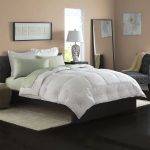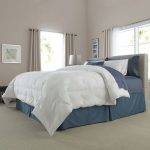Everything You Need to Know About the Pacific Coast Down Comforter
When the human body goes into “sleeping mode”, the natural temperature lowers a couple of degrees. As people fall asleep, this temperature gradually lowers, and slowly starts rising once sleepers are closer to waking up. However, it’s important to regulate body temperature as it drops, preventing discomfort that could lead to a startling wake up call. Sleeping under the right comforter can make a world of difference when it comes to regulating temperature, but how does one tell which is the best personal option in an ocean filled with different choices?
To better understand this topic, we’ve divided this article into three separate sections. This will help you see the bigger picture, and understand more about your body, how temperature affects the quality of your sleep, how down comforters may seem identical but are different from one another, and how Pacific Coast has managed to become the number one down comforter provider of the United States.
Table Of Contents
- Everything You Need to Know About the Pacific Coast Down Comforter
- 1. AllerRest® Down Comforter
- 2. Grand Down Comforter
- 3. Light Warmth Deluxe Down Comforter
- <span style=”font-weight: 400;”>Sleep Thermoregulation</span>
- <span style=”font-weight: 400;”>Body Temperature vs. Sleep Quality</span>
- <span style=”font-weight: 400;”>Types of Comforter Fills</span>
- <span style=”font-weight: 400;”>Natural Down</span>
- <span style=”font-weight: 400;”>Cotton</span>
- <span style=”font-weight: 400;”>Wool</span>
- <span style=”font-weight: 400;”>Polyester</span>
- <span style=”font-weight: 400;”>Silk</span>
- <span style=”font-weight: 400;”>Goose Down vs. Duck Down</span>
- <span style=”font-weight: 400;”>Fill Power</span>
- <span style=”font-weight: 400;”>Baffle Box vs. Sewn-Through Construction</span>
- <span style=”font-weight: 400;”>Who Is the Pacific Coast?</span>
- <span style=”font-weight: 400;”>How to Choose Your Pacific Coast Bedding</span>
- <span style=”font-weight: 400;”>How to Care for Their Products</span>
- <span style=”font-weight: 400;”>Comforters</span>
- <span style=”font-weight: 400;”>Feather Beds</span>
- <span style=”font-weight: 400;”>Return Policy</span>
- <span style=”font-weight: 400;”>Warranty Information</span>
- <span style=”font-weight: 400;”>30-Day Allergy Free Warranty</span>
- <span style=”font-weight: 400;”>A Closer Look at the Products</span>
- <span style=”font-weight: 400;”>Conclusion</span>
Everything You Need to Know About the Pacific Coast Down Comforter
1. AllerRest® Down Comforter – Editor's Choice
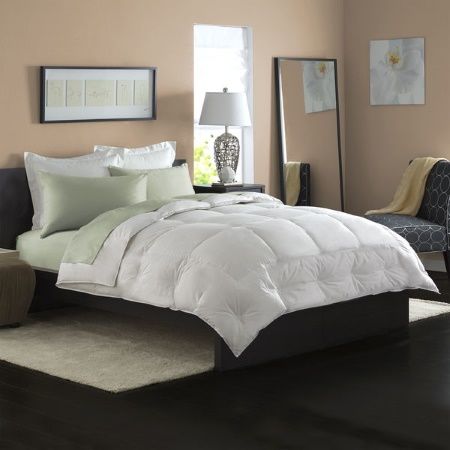
Pros
- Sewn-through box construction.
- Cotton outer shell.
- 300 thread count.
- 550 fill power.
- Corner duvet loops.
- Allergen-free.
Cons
- Best to clean with a professional laundry service.
- Spicy price.
The AllerRest® is probably one of the best down comforters sold by Pacific Coast. Its high-quality fill and the techniques used to make it are something worth talking about. The first thing that stands out when you look at the comforter is the printed duvet loop. They are placed in all four corners of the comforter, making sure that it stays in place when you place it inside the duvet cover. All you have to do is secure the comforter to the duvet cover by using ribbon ties or clips to attach these loops and hold the comforter in place.
The sewn-through box design connects the top and bottom layer of the outer shell, to create a grid where each square contains the same amount of fill as the others. This technology is what prevents the down from shifting inside the comfort, translating into even warmth no matter which part of the comforter you’re lying under.
The outer shell of the comforter is made from cotton, with a thread count of 300. Despite the “low” thread count, this is a luxurious down comforter, which just goes to show you that a high thread count is not the sole indicator of high-quality fabric.
There’s also the Comfort Lock border to talk about, which is a border system that’s made to keep them down in the center. The benefit is that the town that’s close to the edge of the comforter won’t just shift to the border. Remember that when you come across a comforter that takes a lot of extra measures to keep the down in its proper place, is something you might want to look into.
2. Grand Down Comforter
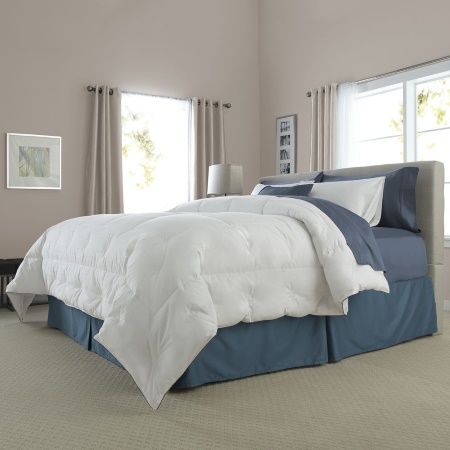
Pros
- Perfect for large beds.
- Measures 120 inches in width.
- 550 fill power.
- 300 thread count.
- Double border construction.
- Hypoallergenic.
Cons
- Crunchy noise.
- Size makes it hard to find a suitable duvet cover.
Looking for huge and wide down comforter? Made exclusively in a King and Cal King size, this is one monster of a comforter. It features all of the benefits that we’re used to getting from a Pacific Coast comforter. The Double Comfort Lock is actually a double border found on the bottom side and the lateral edges of the comforter. Basically, the comforter gets its extra-size precisely from the addition of this second border, with carefully sewing mechanisms that allow the border to maintain their fluff.
The comforter has a fill power of 550, being suitable for all-year-round use. The cotton cover is soft and pleasant to the touch, while the 300 thread count is an assurance of quality of durability. The sewn-through box design was used to make this comforter, making sure that the product maintains even insulation features throughout its entire surface.
The comforter measures 120 inches in width, thus being about 20 percent larger compared to other similar products that are labeled under the King and Cal King sizes. As we’ve mentioned before, the down that was used to make the filling was subjected to the Hyperclean® cleaning process, making the product allergen-free and suitable for people that are sensitive to all sorts of allergy triggers.
3. Light Warmth Deluxe Down Comforter
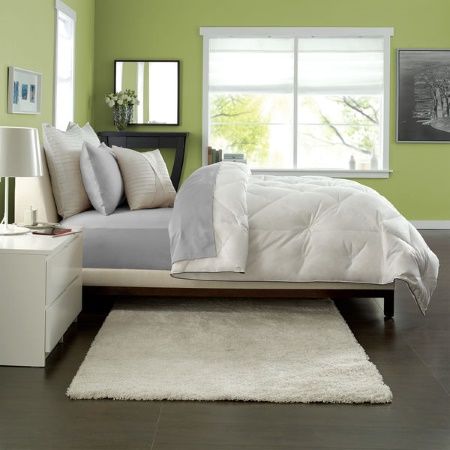
Pros
- 500 thread count.
- Corner duvet loops.
- 600 fill power.
- Cotton outer fabric.
- Quality white goose down filling.
- Comfort Lock border.
Cons
- Good insulation, not suitable for summer use.
We’ve chosen this particular Pacific Coast comforter because of the many words of praise it’s received from happy customers. The Light Warmth Deluxe has a higher fill power compared to the other two products we’ve talked about today, going all the way up to 600.
The quality of the outer shell goes even further, as the combination between the cotton fabric and the 500 thread count raise this product on the luxury ladder with quite a number of steps. The Light Warmth Deluxe comforter also features printed duvet loops, meant to secure the corners to the duvet cover, keeping the comforter in place no matter how much you toss, turn, kick, throw, push or pull the comforter as you sleep.
While it’s being advertised as suitable for warmer climates, we can’t help but wonder if the high fill power might not be best matched with lower temperatures. Inside the cotton shell, we find white goose down, which has excellent insulating properties. The choice of filling ensures us that we’re dealing with a fluffy comforter, since down doesn’t really have any hard parts, unlike feathers.
The construction of this particular down comforter is a bit different. The box stitching was replaced with a sewn-through diamond construction, but the properties and benefits remain pretty much the same. The squares are still here, making sure that the town doesn’t shift as you move underneath the covers, so you can enjoy the even distribution of the down across the entire surface of the comforter.
Sleep Thermoregulation
The human body has this wonderful ability of self-adjusting its temperature, by regulating it so that it stays at a constant level throughout the day. To do so, the body manages to balance heat absorption and loss.
The temperature of the human body tends to get high and low during an entire day. The same thing happens at night, only at a slower pace. When your body is getting ready for sleep, the temperature tends to drop slightly. When it loses heat, the body is ready to fall asleep.
But what happens inside your body that causes these fluctuations in body temperature when you’re sleeping? Light is the primary factor that regulates the body’s circadian rhythm. This means that exposure to light triggers your eye receptors, which send signals to your body. This light exposure basically tells your brain that it’s not time to sleep yet, which causes a lower level of melatonin inside your body. When melatonin levels are low, people have a harder time falling asleep.
Interestingly enough, there are actually two different types of body temperatures: the core temperature and the shell temperature. The former is characterized by the temperature of body parts that contain vital organs: from the cranial area to the thoracic cavity. These zones are regulated by the brain.
The shell temperature is affected by the external temperature that the human body is exposed to, and includes, muscles, skin, and subcutaneous tissues. These two might be different, but they are still related, as the core temperature can be conserved and then released through the shell. There are cases where the core temperature of the body reaches high levels. This causes blood vessels to dilate in the skin, which eventually leads to loss of heat. As a natural response, the body starts to sweat, and as sweat evaporates, the body cools down.
When the body’s temperature is too low and you start getting the chills, blood vessels constrict, meaning they are now conserving heat instead of dissipating it. The brain then redistributed the stored heat to keep the vital organs within normal temperature ranges. In order words, non-vital organs are now neglected in terms of heat distribution, which causes the sensation of cold in the body’s extremities, such as the hands and feet.
Body Temperature vs. Sleep Quality
A daunting question that a lot of you might have at this point is how does the body temperature affect the quality of your sleep. To answer this question, a Dutch study was conducted on human participants that agreed to wear thermostats during the observation period. Throughout this study, it was discovered that raising the body’s temperature with just one degree resulted in changes in the quality of sleep.
People have two different sleep stages: light and deep sleep. Then they are sound asleep, the body isn’t that keen on thermoregulation like it is when our sleep is lighter. That’s why a sleeping environment that’s either too hot or too cold can cause disruption in your sleep/wake cycle.
Types of Comforter Fills
Natural Down
What’s inside the actual comforter is called the fill which, depending on what it’s made of, can have higher or lower quality, with better or worse insulation properties. Naturally, the most common and reliable choice is natural down.
Down is characterized by the fluff that’s found under the plumage of ducks and geese. Unlike feathers, down doesn’t have any hard parts, and it’s often used to make the softest and coziest down comforters on the market.
One very unique characteristic of down is that despite its lightweight, it has these amazing insulating properties. However, depending on the nature of the source, down can be really expensive. For example, pure white goose down is found in top-of-the-line comforters, which are also characterized by a higher price. If you want something less expensive, try looking for a combination of down and feathers.
Cotton
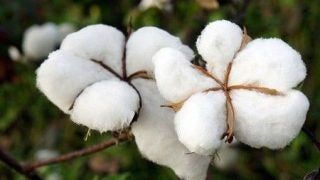
Cotton is the best fabric for making clothes, in a sense that it’s comfortable, moisture-wicking, and feel extremely well when brushing against the skin. As far as comforters are concerned, cotton may be used to fill them, although it’s typically found in blends that combine it with other fabrics.
When manufacturing comforters, there are normally two different types of cotton. The first choice is sanforized cotton, which is shrunk in the manufacturing process, to prevent it from further shrinking as you wash it. The other type is mercerized cotton, which is dipped in a lye solution in order to make it stronger and more absorbent. Some people like to buy comforters with cotton fill instead of down, mostly because they are more affordable and easy to wash at home.
Wool
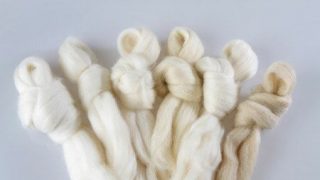
Wool comforters have amazing insulating properties but somehow manage to keep the sleeper cool during the summer. The source of wool used to make comforters is very different, as it can come from different breeds of sheep, alpacas, camels, goats, and others. While wool is a really good material to be used in comforters, it’s generally more expensive to produce, which means that the resulting product is not that affordable. Wool comforters aren’t very common. Despite the fact that they are comfortable and soft, wool comforters are not easy to clean.
Polyester
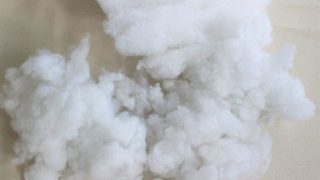
Down alternative comforters are generally made from a mixture of synthetic blends, and most of these include polyester amongst other fabrics. People that buy down alternative comforters do so because they are the most affordable kind. Since the fibers used to make these products are allergen-free, they are also preferred by people who have allergy-related problems. Polyester is not a breathable fabric, and anyone who has ever owned or worn a polyester piece of clothing can stand by this statement. Polyester is still a warm and light fabric, but one that’s also easy to clean.
Silk
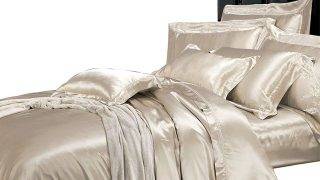
For a very long time, silk was considered a luxury fabric. Extracted from the silkworm caterpillar cocoon, this particular fiber is used to make some of the highest-quality comforters around. Aside from being soft and smooth, silk is also a breathable material, and just about as soft as down. However, silk comforters are really hard to care for, as they require dry-cleaning and are very prone to stains. Even so, the fabric is not just comfortable, but also efficient for sleepers that have allergies.
Goose Down vs. Duck Down

As we’ve previously mentioned, natural down that’s used to make the world’s best comforters is sourced from ducks and geese. First-time buyers might be confused as to which of these types of down is better, so here are a couple of things that might give you the information you’re looking for:
- Goose down and feathers have an odor that’s specific to these birds. Duck down, on the other hand, doesn’t have any odor.
- Both duck and goose down comforters are durable and will maintain their loft and their insulation properties for many years.
- Down that comes from older ducks and geese generally has a higher fill power.
- Overall, goose down is considered as the better fill material all across the industry, so manufacturers claim that goose down comforter is higher-end products.
Fill Power
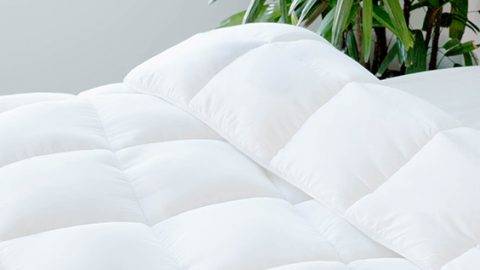
There are a lot of definitions on what comforter fill power actually represents. The mathematical explanation will tell you that it’s a laboratory-tested numerical value that shows how much one ounce of the loft is when translated to cubic inches. The fill power of down is calculated by placing one ounce of down into a glass cylinder and applying a certain amount of pressure through a weighted piston. By compressing the down through controlled humidity and temperature, this test will show the full power of that specific ounce of down.
When a comforter has a lot of fill power, which means that it has better insulation properties.
- Comforters that have a fill power lower than 500 are the least expensive ones. They aren’t that fluffy compared to comforters with more fill power, but they are more suitable for use during the warmer seasons. Lying under a lot of insulation on a warm summer night is just uncomfortable.
- When the fill power of a comforter is between 500 and 600, which means that you get a slightly fluffier comforter. If you are on a lower budget and want a comforter that can be used in moderate weather, this is just about right. However, it can make a wonderful winter comforter if the temperatures inside your home are high during the colder season.
- If the fill power of a comforter is between 600 and 700, which means that you’re dealing with a product that can keep you warm and cozy. These comforters are generally lofty, but still, manage to be lightweight in order for the sleeper to switch positions comfortably.
- When talking about comforters with fill powers that exceed 700/750, this means that you’re now at the higher-end of the comforter-chain. These are the perfect products from winters that bring really low temperatures. The prices are also high, but keep in mind that the fill power is not the sole quality indicator of a comforter (the stitching and the outer shell fabric also play an important part in durability, breathability, and sleeper comfort).
Baffle Box vs. Sewn-Through Construction
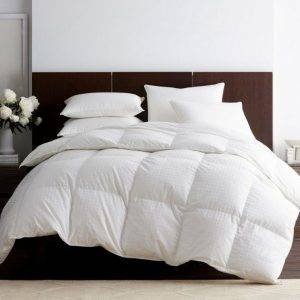
The stitching of a comforter plays an important part in the durability and efficiency of this kind of product. When a comforter is made with a baffle box construction, this means that the top and bottom cover have been sewn together using a thin strip of material.
This stitching is done in a checker pattern, in order to make sure that the fill that’s inside the comforter won’t freely move from one corner to another. This ensures that the down is evenly distributed inside the comforter, which helps the sleeper avoid areas where the comforter is too insulting, or not insulating enough. This type of construction is found on more expensive comforters, but it’s also the most durable choice.
Sewn-through constructions, on the other hand, follow a similar pattern, only they lack the materials strip of baffle box stitching. Because the stitch itself is very secure, the down is kept in place with greater precision. The downside is that this type of construction doesn’t create baffle boxes, which means down is more likely to move around inside the comforter, creating cold spots.
Who Is the Pacific Coast?
Short answer? Probably the number one US company that makes down and feather bedding accessories. They have more than 125 years of experience in making high-quality items based on down and feather fillings. Their luxury bedding items have recently been introduced to European down alternative fiber, looking to up the quality of the otherwise inexpensive and less efficient down alternatives.
Ever since the company was first opened back in 1884, they have constantly been improving and upgrading their products, up to a point where they have become known for being the best in their industry. They are well-known for making luxury down comforters, feather and down pillows, and other bed-related items and accessories. Because their products are extremely qualitative, they became one of the major hotel pillow suppliers in the United States.
How to Choose Your Pacific Coast Bedding
Pacific Coast is great at making three main products: comforters, feather beds, and pillows. To pick the best comforter for you, you need to know what to look for in a down comforter. The advice given in the first part of this article may be of great use to you, so you can fully understand what makes one comforter different from another. For example, the warmth level (a.k.a. the fill power) is a very important factor that needs to be taken into account when browsing for your next comforter.
Featherbeds basically act like mattress toppers. They are placed on top of the mattress and are aimed at giving sleepers that extra layer of comfort. If you have a mattress that’s of a firmness level too high to be comfortable for your body shape and sleeping position, and you want to avoid buying a new one, you can invest in a feather bed.
Pacific Coast currently offers two different feather bed constructions: babble box and baffle channel. The former variety isn’t as flexible as the latter, but it’s also easier to care for. That’s because the baffle box stitching will keep the down in place, preventing it from shifting around inside the comforter and creating empty or lumpy patches.
The baffle channel type of construction is more flexible in terms of how the feathers are positioned. This is useful for people who prefer to have higher/lower insulation levels in specific parts of their comforter. For instance, if you normally sleep hot, but have blood circulation problems that keep your feet cold, you can shift the fill to better insulate the lower part of your legs.
Last, but not least, Pacific Coast makes some really comfortable pillows. If you’re looking for a new pillow, it’s important to know that the elevation provided by this bedding item should prevent strain on the neck, so information on your shoulder size might be helpful. Choosing the best pillow is also a matter of favorite sleeping positions, as the pillow’s job is to support the head into a position that doesn’t put any strain on your shoulders or neck, while also supporting the spine to lie in a natural position.
How to Care for Their Products
While comforters are one of the best ways to stay warm and cozy in bed, people often find that caring for them is not as easy as expected. In order to enjoy the benefits of your Pacific Coast bedding items for many years to come, here are some tips on how to care for these products.
Comforters
The biggest secret to caring for a comforter is taking all the measures required to avoid washing it as much as possible. In order to do so, here are some things you can put into practice:
- Comforters that are made from natural down and feather are typically paired with an outer shell made from natural and comfortable fabrics, such as cotton. Since the best products in this category don’t use any artificial dyes, to prevent making bedding items that are filled with toxins, these comforters will most likely be white or have a natural color to them. This means that they can easily get dirty. To prevent that from happening, consider using a duvet cover, and wrap up the comforter inside it. This way, not only will you keep your comforter clean for a longer period of time, but you also have the benefit of choosing a cover with a pattern and color of your choice. Just make sure that the duvet cover is not colored with cheap dyes that will rub the color off their surface, and stain the comforter.
- Every time you make your bed, try to fluff the comforter. When it receives a steady flow of air, the loft gains more density, which leads to a poofy and extremely comfortable duvet for many years to come.
- If you have a heavy winter comforter that you use only in the colder seasons, you’re probably going to store it away when not in use. At this point, it helps if you use a breathable storage bag, and steer clear from plastic containers. Plastic has the ability to trap moisture inside the bag, which could then lead to your comforter gathering up mildew in the filling.
- If you don’t have a baffle box comforter, then you might have to redistribute the fill throughout the duvet. This can easily be done by placing the comforter on a flat surface and pushing the fill into the desired direction, by using your bare hands. Use your forearm and the heel of your hand to push the comforter in the more empty spaces.
Eventually, there comes a time when you will have to wash your comforter. Pacific Coast recommends turning to a professional cleaning service, not because the process of caring for the comforter is too complicated, but mostly because their comforters are too big to fit in a home washer and dryer.
Since home washers are too small to fit an item that’s this big and fluffy, professional cleaning is a much better choice. Even more, your regular washing machine may have a center agitator, which puts a lot of stress on the comforter, leading to unnecessary wear and tear.
There are also chances of you damaging the comforter by using the wrong type of detergent. Harsh detergent will have a negative impact on the down clusters because they make it dry and brittle.
If you decide to care for your comforter in your own home, keep in mind to use mild detergents. Also, a low heat dryer cycle is recommended, because heat can cause cotton outer shells to shrink. After washing and drying your comforter, make sure that you leave it hanging in a well-ventilated sport for about 12 more hours. Don’t line dry your comforter: always use a dryer even if you leave it the 12 extra hours afterward.
Feather Beds
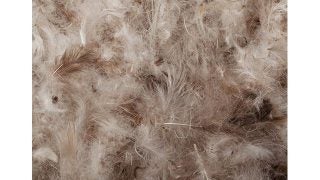
A feather bed is a really good investment that adds extra cushioning and comfort to your sleeping style. Caring for your feather bed will ensure that you can enjoy its comfort for the year to come, and here are some tips to put you on the right track:
- When you receive your new feather bed, it’s recommended that you shake it and leave it in a well-ventilated spot for a few hours. This will make sure that the feathers are all fluffed up, and the bed is more comfortable.
- From time to time, it’s best if you flip the bed over but also rotate it. This will help maintain an ever feather distribution across the entire surface of the bed. You can also do this manually, by pushing the feathers with your hands in the desired spot.
- Keeping your feather bed covered does as much good as placing a fitted sheet on a mattress. It helps keep the topper clean for a longer period of time, prevents wear and tear, and makes it easier for you to care for the bed, as all you have to do is remove the sheet, throw it in the washing machine, and put a clean one on the bed.
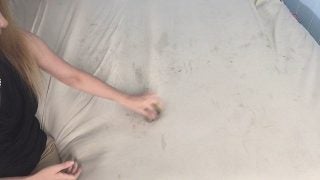
Of course, all these measures will never eliminate the need to clean the bed. Keep in mind that caring for a feather bed is pretty much like caring for your mattress. Spot cleaning is the way to go when faced with minor dirty spots, but overall cleaning is best left in the hands of a professional service.
Return Policy
Every online purchase should be accompanied by a careful review of the return policy for these products. One of the most important bits of information related to returning a Pacific Coast product is knowing that you can’t exchange it. The company no longer accepts exchanging merchandise, but you can return a product and then place a new order for another item that you desire.
If you want to return an item you purchased from Pacific Coast, here are the steps required:
- Inside the package of the product you ordered, you should find a return slip. Fill in the required information, which also requires a brief description of the reason why you want to return the item in the discussion.
- You will also receive a return shipping label. Attach this label to the package using clear tape. Whatever delivery service you use to return the product, make sure that you get proof of delivery. If the item is lost during shipment and you don’t have this delivery proof, Pacific Coast will not be able to give you a refund. It’s important to use carrier services that allow you to track your package at all times.
- When Pacific Coast receives the returned product, they will issue a refund in 14 business days. Please take note that the customer is the one that has to pay for the return shipping fees.
- If you have any questions regarding the products you want to return, or if the return steps are unclear, dropping the support team a line can prove to be useful.
Warranty Information
The warranty period of a product can make or break the deal. When companies really stand by their products and want to reassure their customers that they really sell top-notch items, they will provide an extended warranty period, because they’re sure their products are up to the challenge. Analyzing the warranty details of the Pacific Coast products will provide us with more information on what the company really feels about their products.
Every product made and sold by Pacific Coast comes with a warranty. This information is specified on the labels and packages of the products you buy. You can use the website’s online warranty registration feature, to enjoy the full benefits.
Pacific Coast asks all of its customers to use the product for 30 days before trying to return it. That’s because it sometimes takes some time for the sleeper to fully adjust to the pillow/feather bed/comforter they’ve just purchased. If you are not satisfied with your purchase, you can ask for a full product refund.
What some of you may not know is that this precise dirt and dust is what triggers the allergy in the first place, not the feathers or the down, as it was initially thought. The result is a filling that is four times cleaner compared to what’s inside comforters made by other brands.
To clean the down, Pacific Coast uses biodegradable cleaning agents that the company has personally been working on ever since the company was initially founded. When down is cleaned by using harsh chemicals, this modifies the neutral pH of the filling, which can trigger allergies. If you use a Pacific Coast comforter and experience any allergic symptoms, you can return the product within a 30-day window.
30-Day Allergy Free Warranty
Pacific Coast comforters are made with natural fillings, which means that you get down and feather products that are high-quality and allergy-free. To stand by this promise, the company has initiated a 30-day allergy free warranty, which is very interesting, to say the least.
How does it work and what can this warranty do for you? To explain that, we need to talk about how the quality of the filling in the down comforters. Pacific Coast uses the Hyperclean washing process to wash the down that is used in their products. This is a process that involved washing and rinsing the down at least eight times before using this. The process helps filter out dirt and dust.
A Closer Look at the Products
Down comforters are the items that the Pacific Coast takes most pride in. Reviewing their entire collection would probably bore you to death, so we’ve handpicked three of their most interesting models, and here’s what we discovered about each of them.
Conclusion
There are many different details that set apart the Pacific Coast from the competition. First off, it’s the fact that they never make a false claim or fluff their advertising bits to delude customers into thinking that their comforters will solve all their problems. In their over 125 years of activity, Pacific Coast has managed to find a successful formula that brings the comfort and warmth that people expect to get when they pay hundreds of dollars for a down comforter.
As a result, the company has, slowly but surely, become a leader in its industry, but not just through the quality of its product, but also thanks to their wonderful customer service, and buyer-oriented policies. The warranty claims are those of a company that stands by the quality of its products, and while looking at the big picture, it’s easy to see why Pacific Coast is pure down comforter awesomeness.

